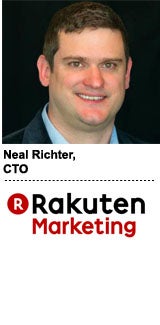RTB whiz Neal Richter is the new CTO at Rakuten Marketing, the marketing solutions subsidiary of Japanese ecommerce giant Rakuten.
Richter, who serves as a technical adviser to a number of ad tech startups, including Metamarkets and nToggle, joins the company after more than seven years with Rubicon Project, most recently as CTO.
At Rakuten, he’ll be responsible for driving technology innovation and uncovering revenue opportunities for the company’s advertiser and publisher customers.
Richter has quite the resume. In addition to helping pioneer programmatic specs like the OpenRTB standard and IAB Tech Lab initiatives like Ads.txt, he led a team of data scientists focused on artificial intelligence and machine learning at CRM company RightNow (acquired by Oracle in 2011).
Like some of its competitors, Rakuten Marketing has constructed its stack through a series of acquisitions, which range from smaller purchases, such as mobile demand-side platform Deep Forest Media and attribution tool DC Storm, to splashier deals, such as Rakuten’s acquisition of display platform MediaFORGE and the subsequent merger with its affiliate network, LinkShare.
Although affiliate marketing has long been the foundation of Rakuten Marketing’s business, the next opportunity lies in moving up the funnel into video as it seeks to unify formats like affiliate, display and mobile into “one holistic marketing channel,” said Tony Zito, CEO of Rakuten Marketing.
Zito and Richter spoke with AdExchanger about how Rakuten is evolving as performance blends with branding.
AdExchanger: Why move to Rakuten Marketing, Neal?
NEAL RICHTER: I was looking for a company with a big vision, a great team, lots of data assets and some large engineering problems to go after.
How will you help Rakuten Marketing compete over the next decade?
Their customer base on the advertiser/retailer side and these new-age, nontraditional publishers essentially have the same needs: to trade with each other and build a marketplace, especially with the transition to mobile and video.
For the youngest demographics, mobile is how they find information and how they buy. The companies that will win in the future are those with lots of interesting and disparate, but complementary, data sets that they’re able to smelt into insights that [improve] consumers’ shopping experiences.
What engineering problems are you tackling?
I’m just getting started, but my background has been at two large companies that were fairly acquisitive, so I’m familiar with how you integrate disparate engineering teams and create common objectives for what the technology needs to evolve to be.
There’s AI and machine learning and then there’s also the practical engineering side of just, “How do we get things done?”
Where does Rakuten Marketing have the most runway?
TONY ZITO: To be frank, there’s a tremendous amount of opportunity that still exists within our publisher network and on the affiliate side. And there are critical channels emerging, like video, which represent really fertile ground for us.
Neal’s a remarkable fit for us because not only did he pioneer some of the RTB technology we all use today, he also understands the needs of the publisher, having worked for a company focused on publisher monetization for the last seven years.
Competitors like Criteo also want to get into video. What’s your biggest challenge, coming into this game kind of late?
ZITO: There are a ton of opportunities within Rakuten’s broader footprint for video, such as [our messaging platform] Viber. We also recently acquired a company called ShopStyle [from PopSugar via Rakuten’s Ebates business], which fits in well with our core vertical of fashion, retail and luxury.
With respect to video, the challenge for [everyone] has been approaching it from a performance perspective. It took a couple of years for the market to start viewing brand budgets as something that was even measurable – or should be measurable – beyond just reach.
Our advertisers are looking for real outcomes with respect to their media investments. If the market continues in that direction and we see more of this brand and performance approach to video, we feel well positioned.
How does ecommerce need to evolve most?
RICHTER: There are a couple of large companies in the world using scaled machine-learning techniques with massive pools of data that are driving differentiated value. The ecommerce experience adapts to that customer’s prior behavior and that’s exactly what programmatic technology has been really good at.
It’s not going to be acceptable for an ecommerce provider to give one person the same experience as someone else. It has to be adaptive to what you did in the past and the companies that do that are doing well.
Isn’t this partly about attribution?
RICHTER: To the extent that attribution technology and data can help model the path to purchase better, everyone’s experience gets subtly better from a consumer perspective. The interesting thing about attribution solutions and the wider acceptance of them is it shows advertising needs to be at the heart of marketing technology to improve the user experience.
How do publishers improve their own experience, taking a page from the platform playbook?
RICHTER: Web pages today are often overloaded with technology. Browsers weren’t built to do what they’re doing today. They’re not application servers, yet they’re being asked to consume hundreds of elements of technology solutions that are beyond the capacity of the web server of the publisher they’re communicating with.
That’s creating a discrete cost for consumers for content they’ve explicitly chosen to consume.
What’s the impact?
RICHTER: It’s having a cost on your battery life, CPU and your cellular data bill. Advertising needs to be highly relevant and, frankly, publishers need to pay close attention to the performance of their website.
Otherwise, you’re optimizing for now, but cannibalizing your future by driving your customers away because your experience is bad. Google AMP and Facebook Instant Articles are about making the web fast. Fast is a feature. There’s too much technology on web pages right now without measuring properly what the overall experience is for consumers.
Interview edited for clarity and length.













